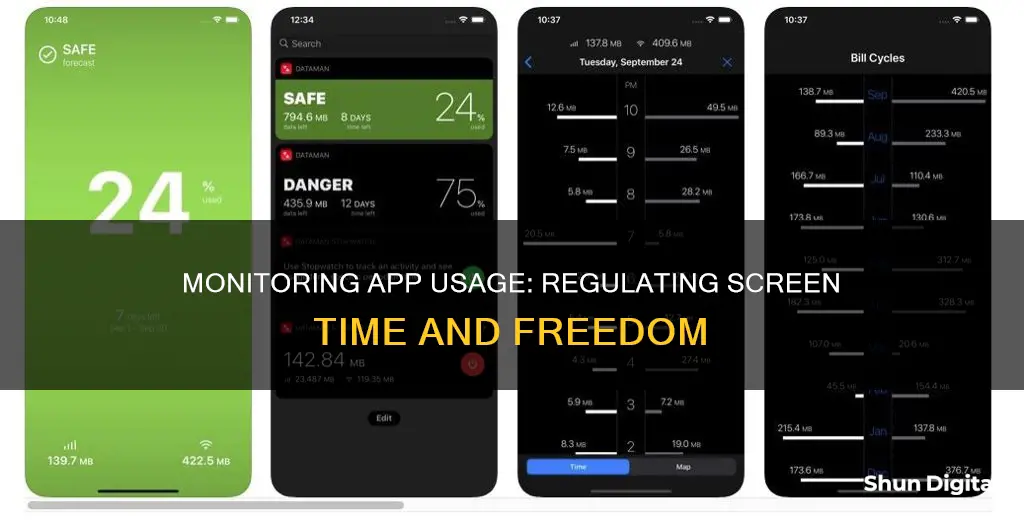
Many people find themselves addicted to app usage, leading to repetitive usage and unhealthy dependence on apps, which increases time spent looking at screens and reduces time spent socialising. To address this, there are a variety of app usage trackers available for mobile, web, and desktop. These trackers can help you monitor your app usage during your free time and provide an illuminating picture of what's dominating your attention, from time spent on email and websites to social media apps. This awareness can help you build greater digital self-awareness and enable you to be more intentional about how you use your devices.
| Characteristics | Values |
|---|---|
| Platforms | iOS, Android, Windows, Mac, Linux, Wear OS, Chrome, Firefox, Safari |
| Purpose | Monitor app usage, limit screen time, improve productivity, reduce addiction |
| Features | Set time limits, block apps, notifications, reminders, detailed usage history, cross-platform, battery-efficient, password protection, customisation, cloud sync, lightweight, private |
What You'll Learn

Monitor app usage to improve productivity and self-control
It is important to monitor your app usage to improve productivity and self-control. App usage trackers can help you become more conscious of your digital activity and intentional about how you use your devices. They provide an illuminating picture of what's dominating your attention—from time spent on emails and websites to social media apps—to help you manage your time more effectively.
There are a variety of app usage trackers available for mobile, web, and desktop. These include:
- IOS' Screen Time: This feature found in your Settings menu tracks how you use your device, providing a high-level evaluation of the time spent on it in a day, as well as a detailed look at time spent in certain apps.
- Moment (iOS and Android): This app sets daily limits on your app usage and sends automatic notifications when those limits are exceeded. It also has a 'Moment Coach' feature that teaches you how to be more mindful when using your devices.
- Digital Wellbeing (Android): Released in 2018, this app offers tools to place limits on when and how you use your Android device, helping you strike a positive balance between your digital and physical life.
- Quality Time (Android): With over 1 million downloads, this app has an intuitive, clean layout that shows your digital actions in chronological order, totalling up individual app utilization and device use frequency. You can also set up pop-ups for when you've been on an app too long, mute notifications, or block apps when at work.
- Timely (Mac, Windows, Web): This app automatically records all the active time spent across web and desktop apps to a secure, private timeline. It's especially handy for understanding how you work, as you can see exactly where your day goes and where you get distracted.
- Dewo (Mac, Windows, Web): This app uses the same automatic time-tracking technology as Timely and helps you take back control of your thinking space by blocking distracting apps to protect space for uninterrupted deep work.
- StayFree: This app helps you block apps and set thoughtful limits on your usage. It also allows you to schedule time away from your phone throughout the day and view simple breakdowns of your usage history to gain a better understanding of your phone usage.
Tips for Improving Productivity and Self-Control:
- Set daily limits: Use apps that allow you to set daily limits on your app usage and send you notifications when you exceed those limits.
- Block distracting apps: Identify apps that distract you and use features in apps like Dewo and StayFree to block them temporarily or permanently.
- Schedule time away from your phone: Use features like 'Focus mode' in StayFree to create schedules to block all distracting apps at specific times, such as during work or study periods.
- View usage history: Analyze your usage history to understand your habits and identify areas where you can improve self-control.
- Increase digital wellbeing: Take regular breaks from your devices to improve your digital wellbeing and spend quality time with family or yourself.
By using these app usage trackers and following the tips provided, you can improve your productivity and self-control, leading to a healthier relationship with technology.
Nevada Power Co: Monitoring Customer Usage and Bills?
You may want to see also

Track screen time to reduce phone addiction
It is becoming increasingly common to feel addicted to our phones. This can lead to unhealthy dependence and repetitive usage, with people spending more time looking at screens and less time socialising with others.
Tracking screen time can be an effective way to reduce phone addiction and encourage healthier habits. By monitoring app usage, you can gain a better understanding of your digital habits and make conscious decisions to reduce your screen time.
How to track screen time
There are several apps available that can help you monitor your screen time and app usage. These apps usually work across mobile, web, and desktop, so you can get a complete picture of your digital activity.
Features of screen time tracking apps
Screen time tracking apps typically offer features such as:
- Daily limits on app usage
- Notifications when limits are exceeded
- Blocking or limiting distracting apps
- Detailed breakdowns of usage history
- Insights into battery health and device performance
- Monitoring of location and online activity
Benefits of tracking screen time
By tracking your screen time, you can:
- Increase your digital self-awareness
- Manage your time more effectively
- Improve your productivity
- Gain a better understanding of your digital wellbeing
- Reduce distractions and boost focus
- Spend more quality time with family and friends
Tips for reducing screen time
In addition to using a screen time tracking app, here are some tips to help you reduce your screen time:
- Prioritise family and social time: Engage in face-to-face conversations and give your loved ones your undivided attention.
- Plan screen-free time: Communicate your goals and work towards reducing your screen time gradually.
- Lead by example: Opt for alternative activities, such as reading a book, instead of using your phone.
- Promote outdoor activities: Encourage engaging activities that are more appealing than screen time, such as spending time outdoors.
- Limit handheld device use: Keep screens out of sight during designated screen-free hours to minimise distractions.
How to Monitor Data Usage on iPhone 6
You may want to see also

Set time limits and block apps to improve work-life balance
It's easy to get sucked into your phone, spending hours glued to the screen and losing track of time. Luckily, there are many apps available to help you monitor your screen time and set time limits to improve your work-life balance.
Built-in features
If you have an iPhone, you can access Apple's built-in screen time app by going to Settings > Screen Time. Here, you can set usage limits for all your apps, schedule downtime, and choose which apps you want to allow at all times. You can also view graphs and stats of your screen time to see how much time you've spent on your phone and which apps are dominating your attention.
Android phones also have a built-in feature called Digital Wellbeing, which can be accessed by going to Settings > Digital Wellbeing and parental controls. Here, you can set app timers to restrict the amount of time spent on specific apps, and use Focus Mode to block or allow certain apps.
Third-party apps
There are also many third-party apps available that can help you monitor and limit your screen time. Here are some popular options:
- Moment – available on iOS and Android, this app sets daily limits on your app intake and sends automatic notifications when those limits are exceeded. It also includes daily 'Moment Coach' exercises to help you be more mindful when using your devices.
- StayFree – this app helps you block apps and set time limits, schedule time away from your phone, and view detailed breakdowns of your usage history. It is available for Windows, Mac, Chrome/Firefox browsers, and any device you own.
- Quality Time – with over 1 million downloads, this Android app has an intuitive, clean layout that shows your digital actions in chronological order, totalling up individual app utilisation and device use frequency. You can also set up pop-ups for when you've been on a particular app for too long, mute notifications, or block apps when you're at work.
- Social Fever – this app has a simple interface that shows you how much time you're spending on various apps, including social media. You can easily set timers to notify you when you've exceeded your limits, and it doesn't require you to set up an account.
- Freedom – with over 2 million users, this app allows you to create blocklists and schedule time away from distracting apps. It is available for iOS, Android, Mac, Windows, Chromebook, and Linux.
- BreakFree – this app gives you a clear picture of how you're spending time on your phone, letting you know if you're spending too much time on specific apps. It also allows you to block access to incoming messages or other apps during a defined time frame, helping you unplug and spend time with loved ones. It is available on iOS and Android.
By using these built-in features and third-party apps, you can gain a better understanding of your screen time habits and make conscious efforts to reduce your usage and improve your work-life balance.
Monitoring Data Usage: Net10 Mobile Hotspot Guide
You may want to see also

Monitor children's app usage and screen time
Monitoring children's app usage and screen time is an important aspect of parenting in the digital age. Excessive screen time can negatively impact children's sleep, mental health, and overall well-being. Here are some strategies and tools to help you effectively monitor and manage your children's app usage and screen time:
Understanding the Importance of Monitoring
The average American scrolls through an astonishing amount of mobile content daily, equivalent to the height of the Statue of Liberty. Excessive screen time can lead to unhealthy habits and negatively impact sleep and mental health. By monitoring your children's app usage and screen time, you can help them develop a healthier relationship with technology and establish clear boundaries.
Choosing the Right Parental Control App
There are several parental control apps available that can help you manage your children's screen time. Here are some popular options:
- Apple Screen Time: This is a built-in feature for iOS devices that allows parents to set time limits on specific apps or groups of apps. It provides insights into your child's screen habits and is highly integrated with the iOS operating system.
- Google Family Link: This free app is designed for Android families with children under 13. It enables parents to set daily limits, schedule downtime, and block or limit access to specific apps.
- Qustodio: This premium app is suitable for Android families with children aged 13 and above. It offers multiple schedules, detailed activity breakdowns, and the ability to block calls and view text messages and web searches.
- Screen Time by Screen Time Labs: This third-party app is available for both iOS and Android devices. It helps manage screen time, block apps, filter web content, and view web history.
Additional Tips for Effective Monitoring
- Set clear rules: Determine daily screen time limits for weekdays and weekends, especially for social media, entertainment, and gaming apps.
- Designate screen-free times and zones: Encourage device-free periods, such as during dinner or bedtime, and consider creating screen-free zones like the bedroom.
- Keep the conversation open: Use parental control reports as a starting point for discussions about healthy technology use. Regularly talk to your children about their online activities and set expectations together.
- Encourage positive habits: Implement a reward system where children can earn extra screen time by completing tasks or adhering to screen time limits.
- Stay informed: Keep up-to-date with the latest apps and trends to better understand your children's digital environment.
Monitor Broadband Usage: Track Your Data Usage Easily
You may want to see also

Use app blockers to limit unhealthy app dependence
App blockers are a great way to limit your screen time and increase productivity by removing digital distractions and restricting your access to addictive applications. By using app blockers, you can create intentional blocks of time for work or other meaningful activities, helping you stay focused and present in your daily activities.
App blockers allow you to block or restrict access to any app on your device, giving you control over your digital habits. You can choose to block social media, games, or any other apps that may be distracting you from your goals. Many app blockers also offer scheduling features, allowing you to set specific times and days to automatically block apps, ensuring that you stay focused during crucial work hours or study sessions.
Benefits of Using App Blockers
By taking charge of your digital behaviour through app blockers, you can increase your productivity, reduce stress, feel less overwhelmed, and achieve a healthier work-life balance. App blockers can also help you break free from constant phone checking and reduce your dependence on addictive apps, giving you back control of your digital life.
Examples of App Blockers
There are several app blockers available for Android and iOS devices, each with its own unique features. Here are a few examples:
- StayFree - This app blocker helps you block apps and set thoughtful limits on your usage. It also provides detailed usage history and statistics, allowing you to understand your screen time and digital wellbeing.
- Freedom - This app blocker is designed to help you stay focused and productive by temporarily blocking addictive apps. It offers cross-device syncing and a Locked Mode to prevent cheating.
- AppBlock - This app blocker allows you to schedule specific times to lock yourself out of certain apps. It also offers an optional "Strict Mode" that prevents you from changing the rules once they're set.
- FocusMe - This app blocker helps you stay focused and increase productivity by blocking social media, apps, games, or even the entire internet. It also offers features like Pomodoro timers and break scheduling.
Monitoring GPU Usage: A Comprehensive Guide to Tracking Performance
You may want to see also
Frequently asked questions
There are several apps available for iOS and Android devices that allow you to monitor your app usage, such as Social Fever, Offtime, Moment, BreakFree, and Flipd. These apps can help you track the time spent on different apps and set alerts to limit your usage.
Yes, there are parental control apps available, such as AirDroid Parental Control, Kidslox Screen Time Control, and FamiSafe, which allow you to monitor and control your child's screen time and app usage. These apps often include features like location tracking, content blocking, and the ability to set time limits for specific apps.
Yes, some of the apps mentioned above offer free versions or trials. For example, FamiSafe offers a 3-day free trial, while Offtime and Kidslox offer free trials with payment information. Additionally, iOS devices have a built-in feature called Screen Time, which allows you to track and limit your app usage without any additional cost.
Many of the app usage tracking apps also provide tools to help you reduce your usage. For example, you can set daily limits, receive notifications when those limits are exceeded, or even enable repetitive alerts when screen time is exceeded. Additionally, you can try setting specific schedules for using certain apps, muting notifications, or blocking apps during work hours. It's also important to lead by example and promote alternative activities to reduce screen time, such as spending time outdoors or engaging in face-to-face conversations.







